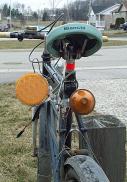
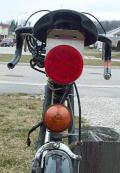
I bought up various 12V white and red LEDs on EBay to make a new head and tail light for my bicycles. These were powered via three 18650 Li-Ion batteries. I've tried 2 and 4 batteries using boost and buck converters to generate a steady 13V but they were so inefficient (60% to 75%) that it wasn't worth it.
Within 3 months it became clear that the first batch I bought was waterproof but the second batch not. Water (salty water in winter) was getting in via the front lens and corroding the LED modules; even though the LED was under yet another plastic cover which is still present in these pictures.




In 2011 I bought a 2W "Blaze" bike headlight from MEC. It was mechanically weak - popping out of the holder twice and after that the front would no longer stay on the body. The light pattern is narrow with a 20 degree width (spot size of 7" at 4 feet).
The Globe LEDMAX 4W MR 16 Floodlight is rated at a "beam spread of 30 degrees", 150 lumens and 30,000h life. The beam spread is easily 4x as wide with the result that the Blaze light has a bright center spot. The spot is roughly 1' at 1' distance - so about 50 degrees. The Globe LED light has too wide of a spot pattern for cycling for my taste.
Nov 2011 I bought a 3.75" diameter LED truck tail light. It has 18 LEDs and draws 280mA (brake light on) or 15mA (running light on) at 13.1V. It's exceptionally bright with the brake light on! The normal price is about $34 but they're on sale at 50% off at times.
The problem using regular trailer lights is that they're not bright - but that can be solved by putting in a 10W halegon lamp. Salt also gets in an corrodes the contacts making the lights unreliable.
May 2008 I recieved this information from M. Smith:
I have modified my Bike to uses led lamps
Auto LED (20 per lamp) fog lights from www.XtraLights.com Shipped from CA.
And the 1157 bulbs for tail/stop lights (LED also){you may find them at
WalMart).
Running all the lamps (2 Brake, 2 Tail and Both Fog lamps & 12V Brake Relay) I achieved about 3 hours before my 12V NiMH battery pack started to die 12V battery pack is made up of 10 x AA 2500ma NiMH batteries.
Bike Brake Light
I now use a magnetic sensor to trip the Relay (small for electronic cct
board) that activates the Dual Brake lights. (my brakes are side pull).
The sensor is from an alarm system (standard rectangular plastic case)that
is mounted above the brake cable on an old clip from the fenders and I
drilled a hole in a magnetic which I slipped over the brake cable and hot
glued in the correct position (does not interfere with the brakes.
This works every time I pull the brakes.
Before I used a switch for the brake sensor but it didn't trip every time I
braked due to the tension on the cable. The magnetic sensor work perfectly.
[Nov 2007] I've started using a Noma 1W LED light that straps onto a help in addition to my 10W bike light. It's bright but awkward on my helmet as it gets knocked off at times. I use it in pulsing mode to get an estimated 2 months of battery life with NiMH rechargables.
[Dec 2007] A friend reports that this works nicely - lots of light from a simple Maglite LED upgrade
Everything below was from the mid 1990's before the age of LED lighting. There are LED modules which can be swaped in for the Halogen lamps. One person mentioned an LED module made by Coast Company from Fry's Electrics for $30 USD. That'll allow a >4x improvment in either power efficiency or power output.
In my case I used this lighting for caving pictures and LED lights leave a lot to be desired in terms of their color as they tend to blue instead of a balanced warm redish color. But as LEDs don't need reflectors to aim the light forward they're more efficient than even the 3x factor you'd guess by looking at the lumens per watt rating. In the case of my current (Feb 2008) bicycle light - a 1W LED headlight seems on par with a 10W halogen.
| Mfg | Power | beam width (degrees) | Use | Life (hours) | Efficiency Lumens/watt |
| GE | 20W, 12V | 15 deg. "Spot" (2.6' wide at 10') | Cycling | 3,000 | aprox 15 |
| GE MR 16 | 20W, 12V | 40 deg. "Flood" | Caving | 3,000 | aprox 15 |
| Globe Electric Co | 10W, 12V | 20 deg. | Cycling | 2,000 | aprox 15 |
| high-eff. LED | 10W, 12V | ? deg. | very long | aprox 80 |
Don's useful LED web page (brightness)
Radiometry and photometry FAQ
Converting from mcd to lumens --> (1 - cos(1/2 of the half-power beam width) ) * 2 pi * candle (brightness)
These halogen lamps, with built in reflectors, are
readily available in stores that stock home lighting equipment.
In Canada this includes Canadian Tire, Home Hardware and Home Depot.
I prefer a 10W halogen lamp for the tail light and they were relatively unavailable until Fall 1999. Home Hardware [Canada] now sells a 2 pack of 10W halogen bulbs for only a few dollars. They have no reflector and are not mounted but are easily soldered into the trailer marker-light that I use as a tail light.
The lamp + reflector is a
one piece unit and costs about $8 Cdn. There is a glass cover on the
front. These lamps run _hot_. You will find that the 20W models almost
fits into a PVC pipe. It does fit into a joining section of PVC with a
bit of carving.
I siliconed a thin plastic
cover over my caving lamp and it melted within seconds. On my
bicycle light I siliconed the lamp onto the plastic cover and I have not had a problem
in 5 years. I only used a
few blobs of silicone on the edges and not a continous seam. That will
allow for some airflow and cooling.
The caving lamp has been dropped and it has fallen into water without problems. Water worked its way
into the reflector once and I turned on the bulb for a few seconds at a time
until the water was vapourized and passed out of the reflector.
On my bicycles I use a tear-drop shaped lighting system that was used by generator powered bike lights in the 1970's and 1980's. This old design used a 1W light and was pretty useless. Just silicone the lamp to the front with a few blobs and drill a hole in the bottom for the power cord. Silicone the wire at the bottom to prevent the steel light housing from cutting thru the power cable.
I use old nicad computer battery packs. You can get them at electronic surplus
stores. You will need to have a way to charge them. I built my own charger.
You can make your own battery pack from C or D sized nicads. The C size is
relatively small and light; although the D sized cells store a lot more charge
and are good for caving; or situations where you can carry the weight.
Some
people use 12V gel cells (like lead-acid car batteries but the acid is in
a gel so it can't be spilled). I used such cells but found their perfomance
to be terrible in -30C weather. I had the cell permenantly attached to the
bicycle so it stayed at < -15C temperature all day long in the winter!
There are also Gates cells that recharge in 20 min and are very light (no liquid inside)
but I have not used them; only looked at data sheets.
The 8W tail light is a marker light from an automative store. Something like $3, sealed for life and it has a steel mounting bracket that I bolt onto the rack mount on my bicycle.
I've just found a 10W halogen bulb:
12V, 10W, 2 bulbs per pack, $4.00 Cdn from Home Hardware, model 04732 JC T3 clear
by Globe Electrical Co Inc. It is rated at 2,000 hours and 130 lumens. I tested
it at 0.86A at 12.4V at room temperature.
The bulbs are without any sort of reflector or protection. I plan to solder wires
to it and epoxy / solder it into a normal trailer amber tail-light.
The efficiency of non-halogen bulbs is poor and experience has taught me that I need to
be very visable to drivers approaching from the rear.
I solder wires to the light and tape/tie-wrap them onto the frame of the bike and then put the connector with some loose wire under the seat. When I want to use it I just uncoil it and plug it into the battery that I'm carrying on my fanny pack or knapsack. I have used a larger battery held from the top-tube of the bike or attached to the seat. But that does not work well in the winter at -15F! and people tend to steal them.
The only problem that I can see is that you have to find some way to charge the batteries. You could use a battery holder for C or D sized nicads and just use a normal nicad charger. My charger is pretty simple but takes 24 hours to charge the batteries and I rotate thru 3 battery packs (always carrying a spare).
The 20W headlight and 8 W tail light run for about 1 hour off of old C sized nicads. ie aprox 2A being drawn * 1 hour = 2Ah capacity. This was the case when my batteries were new. Now that they are 15 years old I only have aprox. 1Ah capacity (ie they last 30 min.) and the cells discharge themselves if unused for 4 days!
My first system used a car headlight, silicon and steel wire. The
whole lamp mount fell appart on me, then I improved that with an aluminum
bracket that attached to the bicycle. It vibrated and fatigued appart in 2
weeks. I have not had any problems with the smaller & lighter 20W systems.
The nice thing is that the batteries were free so I built the
whole thing in a few hours using $12 worth of parts and some wire that
I had sitting around. You will need a soldering iron/gun. Make sure
that you attach the wires to the lamp very well. If you short circuit a
nicad battery pack you will get lots and lots of current; usually enough
to make the wires glow red hot and melt thru most anything. Computer
battery packs usually have fuses that protect against this;
but they also limit the current so much that you can not run a 20W light.
| Type | Size | Standard | High Capacity "E" | Rapid Charge "R" | Super High Capacity "S" |
| NiCd | AA | 500 mAH | 600 mAH | 800, 1000 mAH | |
| NiCd | 2/3 C | 1.0 AH | |||
| NiCd | C | 2.2 AH | 2.8 AH | ||
| NiCd | D | 2.4 AH | 4.4 AH | 5 AH | |
| NiMH | AAA | 0.65 AH | |||
| NiMH | AA | 1.2 - 1.5 AH | |||
| NiMH | C, D | 2.2 AH | |||
| Alkaline | 9V | 0.57 AH | |||
| Alkaline | AAA | 1.1 AH | |||
| Alkaline | AA | 2.5 AH | |||
| Alkaline | C | 7.1 AH | |||
| Alkaline | D | 13 AH | |||
This is a very simplistic way to look at batteries. The problems are:
My system has the following characteristics: 12.8V when charged (10 C cells NiCd) - 2.2A draw for 20W halogen + 8 W tail light 11.8V when about 60% discharged - 2.0A draw for both lights

Here are my two commuter bikes; one for the winter and one for the summer. The orange reflector is a lot brighter than the red one!


Here is a picture of my headlight system; with a 20W halogen bulb + reflector glued into an old bike-light.
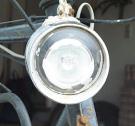
My tail light. First the original one and then a 10W halogen bulb soldered to the old connector with the plastic painted white for extra brightness.

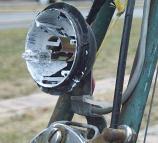

This is a picture of the original taillight bulb and unpainted black interior.
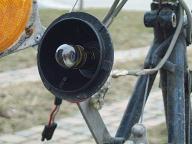
This is my caving light; using the same 20W halogen bulb glued into a piece of PVC tubing.
Actually the tubing is at the back and the bulb has been fit into a piece of coupling. It was nearly big enough and a circular file made it right size.


